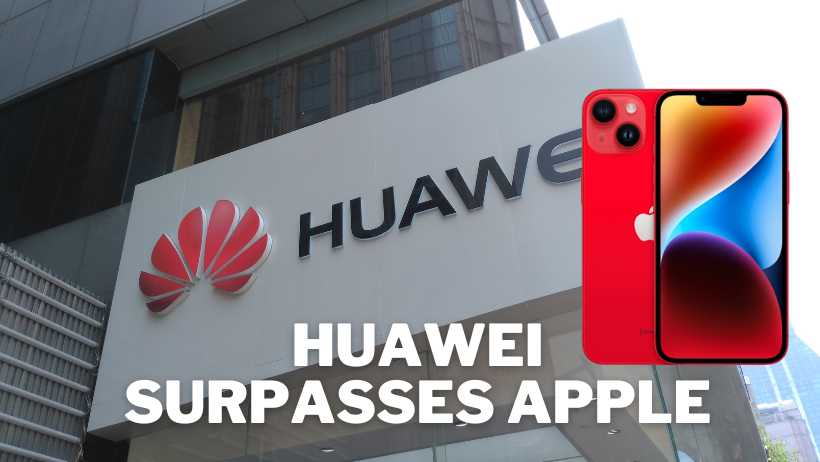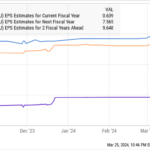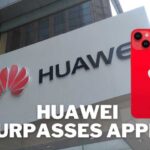
With a remarkable 64% surge in sales, the Chinese telecoms behemoth Huawei has made a huge splash in the smartphone business, overtaking Apple.
Huawei has been successful due in large part to its in-house operating system, HarmonyOS, and its autonomous supply chain. Shenzhen, the center of China’s IT sector, intends to push the adoption of native apps created on HarmonyOS and promote it even further.
The smartphone market domination of Google’s Android and Apple’s iOS is severely threatened by this action. Thanks to its all-encompassing ecosystem, which includes hardware, chipsets, devices, OS, and AI, Huawei is a strong challenger on the world arena. Meanwhile, Huawei’s comeback poses a threat to Apple due to the tech company’s reliance on the Chinese market.
The 64% Gain Puts Huawei Over Apple in Smartphone Sales
Background
Sales data for Huawei smartphones
The sales of smartphones manufactured by the Chinese telecom behemoth Huawei have increased at an astounding rate in the past few years. New data shows that Huawei’s 64% sales gain has put them ahead of Apple in smartphone sales. With these astounding results, Huawei has solidified its position as a leading contender in the worldwide smartphone industry.
Compared to the sales of Apple’s smartphones
Sales of Huawei smartphones have skyrocketed, leading to a heated competition between the two tech companies. Despite Apple’s legendary status as a market leader and innovator, Huawei has emerged as a formidable rival thanks to its recent successes. Huawei is now the world’s number two smartphone maker, surpassing Apple thanks to its rising sales.
Boost in sales of Huawei smartphones
Several things have contributed to the meteoric rise in Huawei’s smartphone sales. Thanks in large part to its autonomous supply chain, which ensures a steady supply of high-quality components, Huawei has been able to sustain its rapid expansion.
Furthermore, Huawei’s HarmonyOS operating system has been instrumental in luring customers looking for an alternative to popular OSes. Let’s take a closer look at these elements that have helped Huawei succeed.
The reasons behind Huawei’s success
Independent supply chain
With its own supply chain, Huawei has a huge leg up on the competition. Huawei makes its own CPUs, cameras, and antennas, which sets it apart from many other smartphone makers.
By keeping all of its operations in-house, Huawei is able to maintain a steady supply of high-performance devices while also improving its control over component quality and availability. Huawei has been successful in keeping its products ahead of the competition in terms of price, quality, and time to market by decreasing its dependence on external suppliers.
Creation of the HarmonyOS software platform
A major contributor to Huawei’s success has been the creation of their operating system, HarmonyOS. Huawei chose to develop its own operating system to safeguard its future in the face of rising conflicts with global software providers like Google.
When it comes to using HarmonyOS, you won’t notice a difference between your phone, tablet, and wristwatch. Its open-source nature paves the way for the creation of complementary apps and services by developers. Consumers seeking alternatives that provide both performance and security have responded positively to Huawei’s commitment to developing a strong and dependable operating system.
Benefits of HarmonyOS Compared to Rivals
Its capacity to build a really integrated ecosystem of smart devices is one of the main advantages that HarmonyOS offers over its rivals, especially Google’s Android and Apple’s iOS. By utilizing a distributed design, the operating system enables devices to collaborate and share resources.
Not only does this integration make using Huawei products more efficient and effective, but it also improves the user experience. Users may rest easy knowing that HarmonyOS is protected from cyber attacks thanks to its top-notch security measures. With these benefits and Huawei’s dedication to innovation and constant development, HarmonyOS is ready to take on established operating systems.
The part played by Shenzhen in promoting Huawei
Shenzhen is the center of China’s technology sector.
The city of Shenzhen in Guangdong province is generally considered to be the technological center of China. A major player in China’s booming digital industry, the city is home to a plethora of cutting-edge tech firms.
A city like Shenzhen is perfect for IT giants like Huawei because of its dynamic ecology, which encourages innovation and teamwork. Shenzhen has become the cradle of revolutionary innovations, contributing to Huawei’s development and success, thanks to its large talent pool, superior infrastructure, and government assistance.
Shenzhen HarmonyOS Promotion
The city of Shenzhen is actively pushing Huawei’s HarmonyOS as part of its mission to foster local innovation. Government officials in the area have made it clear that they want developers, organizations, and enterprises to use HarmonyOS.
A flourishing ecosystem supporting the creation of native apps and services centered upon HarmonyOS is the goal of this collaborative endeavor. Shenzhen is helping Huawei solidify its place as a leading player in the IT industry and boost its competitive edge by concentrating on local adoption and support.
Pay close attention to HarmonyOS native applications.
HarmonyOS isn’t the only thing that Shenzhen is promoting. The local government is pushing for the creation of HarmonyOS native apps. With the goal of improving the performance and usability of Huawei devices, Shenzhen is fostering an ecosystem of app developers and offering resources to help them build new and exciting apps.
This emphasis on native apps does double duty: it strengthens Huawei’s ecosystem and gives developers a platform to show off their work, all while helping the local tech economy expand. The groundwork for future innovations in the IT industry is laid by this mutually beneficial partnership between Shenzhen and Huawei.
Danger to Apple’s iOS and Google’s Android
Huawei’s Rivalry with Android
The continued success of Huawei’s smartphone line presents a serious threat to Android, the market leader. As a result of the continuing trade war between the US and China, Huawei is no longer able to use Google’s services or keep its agreements with US enterprises.
As a counter to Android, Huawei has increased its focus on building its own ecosystem, which includes the HarmonyOS OS. This effort to get away from Android might shake up the smartphone industry and provide users more options when it comes to operating systems.
The effect on Google’s bottom line
Google’s income is affected by Huawei’s rising popularity. Millions of Huawei customers can say goodbye to Gmail, Google Maps, and YouTube, among other popular Google apps, as the world’s largest smartphone maker, Huawei, has decided to build its own ecosystem and move away from Google’s services.
This decline in market share is a major setback for Google’s business model as it impacts the company’s capacity to earn money from ads and gather user data. A major danger to Google’s income sources has emerged with the rise of Huawei as a rival in hardware and software.
As an alternative to Apple’s iOS, Huawei
Even while Apple’s iOS has always been associated with high-quality smartphones and a dedicated fan base, Huawei’s comeback gives customers another option. Huawei is now a formidable competitor in the worldwide smartphone industry because to its dedication to innovation and the creation of HarmonyOS.
When looking for a new smartphone, customers have a lot of options thanks to Huawei’s dedication to developing innovative hardware and the availability of an operating system with many of features.
Growing competition from Huawei’s ecosystem might entice some Apple customers, threatening the tech giant’s market dominance and compelling it to step up its innovation game.
The 64% Gain Puts Huawei Over Apple in Smartphone Sales
ecosystem and competitive advantage of Huawei
Introducing the Huawei ecosystem
Everything from hardware and chipsets to devices and operating systems to AI is part of Huawei’s ecosystem. Huawei is able to provide consumers with frictionless experiences across all of their products, from smartphones and wearables to smart home gadgets and more, because of this comprehensive strategy. Huawei stands apart from its competition and improves the user experience by integrating these components into a unified ecosystem.
Device, chipset, and hardware integration
Integrating hardware, chipsets, and devices into a single ecosystem is one of Huawei’s key advantages. Huawei achieves its exceptional performance and efficiency by developing and improving its own components in-house.
Users are able to move freely between devices without losing functionality or experience because to Huawei’s ability to provide consistent experiences across all of their devices. A key component of Huawei’s ecosystem and a source of competitive advantage is the company’s commitment to deep integration of hardware, chipsets, and devices.
Benefits of an interdependent ecology
There are various benefits for Huawei and its customers in an integrated environment. Huawei believes that a single ecosystem will provide them more control over the user experience by making sure that all of their components function together smoothly.
Huawei is able to consistently and promptly upgrade its devices because of this degree of control over software updates, security fixes, and the introduction of new features. As consumers become used to the faultless experiences and integration provided by Huawei products, a unified ecosystem also helps to cultivate brand loyalty.
A user’s digital life is made easier and more streamlined by a coherent environment. Productivity and convenience are both improved by the ability to link and exchange data across devices without any hitches. Intuitive and unified, Huawei’s ecosystem makes it easy to retrieve files, manage notifications, and sync data.
As an added bonus, customers can take advantage of Huawei’s AI capabilities to their fullest extent inside a single ecosystem, which in turn offers smart, tailored services that adjust to each user’s unique tastes and requirements.
Modern AI advancements and their effects
When compared to its rivals, Huawei stands head and shoulders above the others thanks to its dedication to artificial intelligence. Many new and improved user experiences are made possible by the incorporation of AI into Huawei’s ecosystem.
The AI-driven ecosystem at Huawei may revolutionize user experience across a wide range of products, from smart home automation and sophisticated voice assistants to intelligent cameras with features like scene recognition and real-time object tracking.
Huawei can give personalized suggestions and tailored experiences by analyzing user habits, preferences, and behavior with the power of AI. This degree of personalization allows Huawei to provide tailored services and apps that meet the specific requirements of each user, which in turn increases consumer happiness.
Huawei maintains its ecosystem competitive and relevant in the ever-changing digital world by continuously investing in AI research and development, which places the company at the forefront of technical breakthroughs.
Apple’s exposure to the rise of Huawei
Significant dependence on the Chinese market
Because of its dependence on the Chinese market, Apple is in risk of being overtaken by Huawei’s comeback. An enormous amount of Apple’s worldwide sales have come from the Chinese market.
However, Apple faces serious competition in China from Huawei, which has grown in both popularity and market share. Keeping its market share and position as a top smartphone brand in China is becoming more difficult for Apple as Huawei’s smartphones gain popularity among Chinese customers.
Chinese market share rivalry
Apple and Huawei are locked in a heated battle for a larger slice of the Chinese market. Huawei has found success in China because to its aggressive pricing approach and dedication to meeting local tastes and demands. On the other hand, price-conscious Chinese buyers are angry about Apple’s high prices and poor innovation rate.
In addition, Apple faces a serious threat from Huawei, which has a significant presence in the local market and is bolstered by Shenzhen’s promotion of HarmonyOS. In order to maintain its competitive edge, Apple must tackle these difficulties head-on and adjust its strategy to cater to the Chinese market more effectively.
Methods to combat the expansion of Huawei
Apple must devise plans to combat Huawei’s expansion and preserve its competitive position in light of the company’s recent revival. One strategy is to better understand and meet the needs of Chinese customers by developing features and services tailored to their culture. In order to build a more personalized environment, this might entail forming agreements with local businesses, content providers, or app developers.
Also, to stay ahead of the competition and differentiate its goods from Huawei’s, Apple has to keep pouring money into R&D. If Apple wants to win back the hearts and minds of Chinese customers, it needs to introduce innovative technologies, improve user experiences, and provide features that are on the cutting edge of technology. More cheap choices would attract a broader spectrum of Chinese consumers, thus Apple should think about diversifying its product offering.
Finally, the autonomous supply chain, the creation of HarmonyOS, and the integration of its ecosystem are the reasons behind Huawei’s outstanding performance in the smartphone industry. Huawei is well-positioned to compete with Apple’s iOS and Google’s Android thanks to Shenzhen’s backing and advertising.
Apple is confronted with vulnerabilities in the Chinese market and will need to adjust in order to withstand Huawei’s expansion and innovation. The future of smartphones will be shaped by the battle between these two digital titans, which will drive further innovations and provide customers more alternatives.
The 64% Gain Puts Huawei Over Apple in Smartphone Sales


















